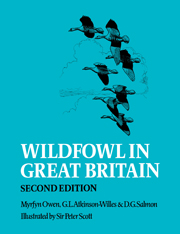Book contents
- Frontmatter
- Contents
- List of location maps
- Foreword by William Wilkinson
- Acknowledgements
- Conventions and abbreviations
- Part I Introduction
- Part II The survey of wildfowl habitat and distribution
- Part III Species accounts
- Introduction
- Principal species
- Other species
- Part IV The conservation of wildfowl and their habitats
- Conclusion
- References
- Indexes
Other species
Published online by Cambridge University Press: 04 August 2010
- Frontmatter
- Contents
- List of location maps
- Foreword by William Wilkinson
- Acknowledgements
- Conventions and abbreviations
- Part I Introduction
- Part II The survey of wildfowl habitat and distribution
- Part III Species accounts
- Introduction
- Principal species
- Other species
- Part IV The conservation of wildfowl and their habitats
- Conclusion
- References
- Indexes
Summary
Lesser White-fronted Goose Anser erythropus
A smaller, close relative of the Whitefront, this species breeds across northern Europe and Asia from Norway to eastern Siberia. It is an upland breeder and migrates through central Europe to winter around the Black and Caspian Seas and south-western Asia. Stragglers to Britain are almost always seen with European Whitefronts; up to 1982 there had been just over 100 records, well over half of these at the New Grounds on the upper Severn Estuary, where it was first recorded in 1945. Before then there had been only 2 sightings, the first in 1886. The largest number present in any one year was 4 at the New Grounds in 1979-80. Probable hybrids with the Whitefront are sometimes reported.
Snow Goose
Anser caerulescens
A numerous species of North America, the Lesser Snow Goose A. c. caerulescens has a blue and a white phase; the Greater Snow Goose A. c. atlanticus has only the white form. Both races, and both phases of the Lesser Snow, occur almost annually in Scotland and occasionally in England, usually with flocks of other geese. The species is, however, commonly kept in captivity in a fully-winged state and it is impossible nowadays to establish which birds are wild. Those accompanying Whitefronts from west Greenland are more likely to be so; a group of 18 seen in the Netherlands in 1980 contained a single adult ringed in southern Hudson Bay.
- Type
- Chapter
- Information
- Wildfowl in Great Britain , pp. 465 - 468Publisher: Cambridge University PressPrint publication year: 1986

